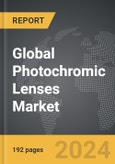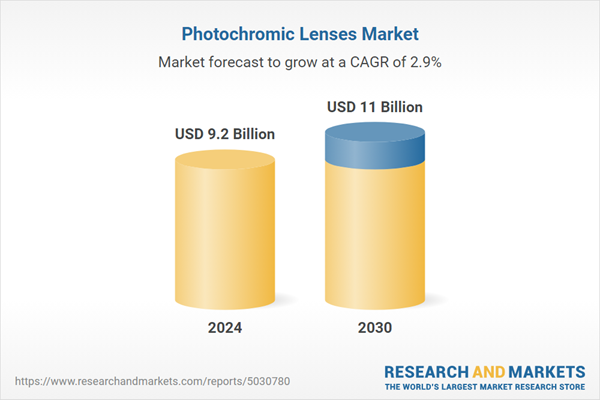The global market for Photochromic Lenses was valued at US$9.2 Billion in 2024 and is projected to reach US$11.0 Billion by 2030, growing at a CAGR of 2.9% from 2024 to 2030. This comprehensive report provides an in-depth analysis of market trends, drivers, and forecasts, helping you make informed business decisions. The report includes the most recent global tariff developments and how they impact the Photochromic Lenses market.
Segments: Segment (Glass, Polycarbonate, Plastic).
Geographic Regions/Countries: World; United States; Canada; Japan; China; Europe (France; Germany; Italy; United Kingdom; Spain; Russia; and Rest of Europe); Asia-Pacific (Australia; India; South Korea; and Rest of Asia-Pacific); Latin America (Argentina; Brazil; Mexico; and Rest of Latin America); Middle East (Iran; Israel; Saudi Arabia; United Arab Emirates; and Rest of Middle East); and Africa.
The analysts continuously track trade developments worldwide, drawing insights from leading global economists and over 200 industry and policy institutions, including think tanks, trade organizations, and national economic advisory bodies. This intelligence is integrated into forecasting models to provide timely, data-driven analysis of emerging risks and opportunities.
Global Photochromic Lenses Market - Key Trends and Drivers Summarized
What Are Photochromic Lenses and Why Are They Important?
Photochromic lenses, often referred to as transition lenses, are optical lenses that darken on exposure to specific types of light, typically ultraviolet (UV) radiation, and return to a clear state when the light source is removed. These lenses offer a versatile solution for eyeglass wearers, providing clear vision indoors and reducing glare from sunlight outdoors without the need for multiple pairs of glasses. The importance of photochromic lenses lies in their ability to protect the eyes from harmful UV rays and enhance visual comfort by adjusting to changing light conditions. This adaptability makes them particularly beneficial for individuals with light sensitivity, those who frequently transition between indoor and outdoor environments, and anyone seeking the convenience of all-in-one eyewear.How Are Technological Innovations Enhancing Photochromic Lenses?
Technological advancements have significantly enhanced the performance and appeal of photochromic lenses. Modern photochromic lenses utilize advanced dye molecules that respond more quickly and efficiently to changes in light conditions, providing faster transition times and better clarity in varying environments. Innovations in lens materials and coatings have improved durability, scratch resistance, and overall optical quality, ensuring longer-lasting and more effective lenses. Additionally, the development of polarized photochromic lenses has combined the benefits of glare reduction and adaptive tinting, making them ideal for outdoor activities such as driving, sports, and hiking. These technological improvements have not only increased the functionality of photochromic lenses but also expanded their appeal to a wider range of users, enhancing both visual performance and eye protection.What Are the Key Applications and Benefits of Photochromic Lenses?
Photochromic lenses serve a wide range of applications, offering significant benefits for various user groups. For everyday eyeglass wearers, these lenses provide seamless transition between indoor and outdoor environments, eliminating the need to switch between regular glasses and sunglasses. This convenience is particularly appreciated by individuals with active lifestyles and those who frequently move between different lighting conditions. In the medical field, photochromic lenses are recommended for patients with conditions such as cataracts, macular degeneration, and photophobia, as they help to reduce eye strain and protect against UV exposure. In the sports and outdoor recreation sectors, these lenses enhance visual clarity and comfort, improving performance and safety by adapting to changing light conditions. The ability of photochromic lenses to combine multiple functions into a single pair of glasses makes them an attractive choice for a diverse range of users seeking both protection and convenience.What Factors Are Driving Growth in the Photochromic Lenses Market?
The growth in the photochromic lenses market is driven by several factors. Firstly, the increasing awareness of the harmful effects of UV radiation and the growing emphasis on eye health are propelling the demand for lenses that offer UV protection. Technological advancements in lens materials and transition speeds are enhancing the performance and attractiveness of photochromic lenses, encouraging more users to adopt them. The rising popularity of multifunctional eyewear that combines vision correction, sun protection, and glare reduction is also contributing to market growth. Additionally, the expansion of the eyewear market in emerging economies, driven by increasing disposable incomes and changing lifestyle trends, is boosting demand for premium eyewear products, including photochromic lenses. The growing prevalence of vision-related conditions and the increasing use of digital devices, which heighten light sensitivity and eye strain, are further fueling the adoption of these adaptive lenses. These factors collectively ensure robust growth and continuous innovation in the photochromic lenses market, highlighting their significance in modern eyewear solutions.Report Scope
The report analyzes the Photochromic Lenses market, presented in terms of units. The analysis covers the key segments and geographic regions outlined below.Segments: Segment (Glass, Polycarbonate, Plastic).
Geographic Regions/Countries: World; United States; Canada; Japan; China; Europe (France; Germany; Italy; United Kingdom; Spain; Russia; and Rest of Europe); Asia-Pacific (Australia; India; South Korea; and Rest of Asia-Pacific); Latin America (Argentina; Brazil; Mexico; and Rest of Latin America); Middle East (Iran; Israel; Saudi Arabia; United Arab Emirates; and Rest of Middle East); and Africa.
Key Insights:
- Market Growth: Understand the significant growth trajectory of the Glass segment, which is expected to reach US$5.1 Billion by 2030 with a CAGR of a 2.5%. The Polycarbonate segment is also set to grow at 2.9% CAGR over the analysis period.
- Regional Analysis: Gain insights into the U.S. market, valued at $2.5 Billion in 2024, and China, forecasted to grow at an impressive 4.6% CAGR to reach $2.1 Billion by 2030. Discover growth trends in other key regions, including Japan, Canada, Germany, and the Asia-Pacific.
Why You Should Buy This Report:
- Detailed Market Analysis: Access a thorough analysis of the Global Photochromic Lenses Market, covering all major geographic regions and market segments.
- Competitive Insights: Get an overview of the competitive landscape, including the market presence of major players across different geographies.
- Future Trends and Drivers: Understand the key trends and drivers shaping the future of the Global Photochromic Lenses Market.
- Actionable Insights: Benefit from actionable insights that can help you identify new revenue opportunities and make strategic business decisions.
Key Questions Answered:
- How is the Global Photochromic Lenses Market expected to evolve by 2030?
- What are the main drivers and restraints affecting the market?
- Which market segments will grow the most over the forecast period?
- How will market shares for different regions and segments change by 2030?
- Who are the leading players in the market, and what are their prospects?
Report Features:
- Comprehensive Market Data: Independent analysis of annual sales and market forecasts in US$ Million from 2024 to 2030.
- In-Depth Regional Analysis: Detailed insights into key markets, including the U.S., China, Japan, Canada, Europe, Asia-Pacific, Latin America, Middle East, and Africa.
- Company Profiles: Coverage of players such as Carl Zeiss Meditec AG, Corning, Inc., Essilor International SA, Hoya Corporation, Optiswiss AG and more.
- Complimentary Updates: Receive free report updates for one year to keep you informed of the latest market developments.
Some of the 38 companies featured in this Photochromic Lenses market report include:
- Carl Zeiss Meditec AG
- Corning, Inc.
- Essilor International SA
- Hoya Corporation
- Optiswiss AG
- Seiko Optical Products Co., Ltd.
- Tokai Optical Co., Ltd.
- Transitions Optical Limited
- Vision Dynamics LLC (Optical Dynamics)
- Vision Service Plan (VSP)
Tariff Impact Analysis: Key Insights for 2025
Global tariff negotiations across 180+ countries are reshaping supply chains, costs, and competitiveness. This report reflects the latest developments as of April 2025 and incorporates forward-looking insights into the market outlook.The analysts continuously track trade developments worldwide, drawing insights from leading global economists and over 200 industry and policy institutions, including think tanks, trade organizations, and national economic advisory bodies. This intelligence is integrated into forecasting models to provide timely, data-driven analysis of emerging risks and opportunities.
What’s Included in This Edition:
- Tariff-adjusted market forecasts by region and segment
- Analysis of cost and supply chain implications by sourcing and trade exposure
- Strategic insights into geographic shifts
Buyers receive a free July 2025 update with:
- Finalized tariff impacts and new trade agreement effects
- Updated projections reflecting global sourcing and cost shifts
- Expanded country-specific coverage across the industry
Table of Contents
I. METHODOLOGYII. EXECUTIVE SUMMARY2. FOCUS ON SELECT PLAYERSIII. MARKET ANALYSISIV. COMPETITION
1. MARKET OVERVIEW
3. MARKET TRENDS & DRIVERS
4. GLOBAL MARKET PERSPECTIVE
UNITED STATES
CANADA
JAPAN
CHINA
EUROPE
FRANCE
GERMANY
ITALY
UNITED KINGDOM
SPAIN
RUSSIA
REST OF EUROPE
ASIA-PACIFIC
AUSTRALIA
INDIA
SOUTH KOREA
REST OF ASIA-PACIFIC
LATIN AMERICA
ARGENTINA
BRAZIL
MEXICO
REST OF LATIN AMERICA
MIDDLE EAST
IRAN
ISRAEL
SAUDI ARABIA
UNITED ARAB EMIRATES
REST OF MIDDLE EAST
AFRICA
Companies Mentioned (Partial List)
A selection of companies mentioned in this report includes, but is not limited to:
- Carl Zeiss Meditec AG
- Corning, Inc.
- Essilor International SA
- Hoya Corporation
- Optiswiss AG
- Seiko Optical Products Co., Ltd.
- Tokai Optical Co., Ltd.
- Transitions Optical Limited
- Vision Dynamics LLC (Optical Dynamics)
- Vision Service Plan (VSP)
Table Information
| Report Attribute | Details |
|---|---|
| No. of Pages | 179 |
| Published | April 2025 |
| Forecast Period | 2024 - 2030 |
| Estimated Market Value ( USD | $ 9.2 Billion |
| Forecasted Market Value ( USD | $ 11 Billion |
| Compound Annual Growth Rate | 2.9% |
| Regions Covered | Global |









